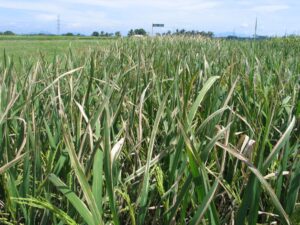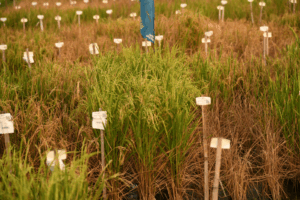On the Danyi plateau in Togo, villagers still bless newly-wed couples by sprinkling rice grains over their heads. They use indigenous African rice, which was domesticated about 3,500 years ago in West Africa. The villagers also continue to appease the souls of their ancestors by offering them this rice.
African rice is not only an integral part of the culture but also the preferred food. “Once you taste our rice, you will never like any other rice and it stays in your stomach unlike the modern varieties,” the women say. The elderly villagers mourn, however, that their children and grandchildren are no longer interested in growing this rice.
According to some historians, Scientists find a treasure trove of information in Africa’s indigenous rice that could help breed better varieties for tomorrow’s generation African rice sustained the great empires of Ghana, Mali, and Songhai in West and Central Africa during the 11th to 16th century. Today, however, this type of rice is becoming extinct as it is grown only in pockets of West Africa. In some areas, the deepwater or floating rice plants belonging to this species are still found.
African rice, whose scientific name is Oryza glaberrima, is unique to Africa. About 450 years ago, the Asian species, O. sativa, was introduced to Africa from Asia and quickly became popular because of its high yield potential.
Over the years, African rice has been replaced in the region by Asian rice because it is prone to lodging (plants fall over) and shattering (the panicle scatters seed at maturity). For years, it has also been neglected by research.
However, new findings presented by Africa Rice Center (AfricaRice) scientists and their partners during the Africa Rice Congress held last 22-26 March 2010 in Bamako, Mali, have sparked renewed interest in this species.
For example, studies have shown that one of the O. glaberrima varieties, CG 14, is weed competitive and has good resistance to iron toxicity, drought, nematodes, waterlogging, and major African rice diseases and pests. It seems to adapt to acid soil with low phosphorus availability.
“Such multiple resistance to indigenous constraints is a highly desirable character for rice cultivated in the rainfed ecology in West Africa by resource-poor farmers, who cannot afford to adopt intensive agronomic measures against such constraints,” said Dr. Moussa Sié, senior rice breeder and coordinator of the Rice Breeding Task Force of AfricaRice.
That is why AfricaRice scientist Dr. Monty Jones and his team selected CG 14 when they decided to cross O. glaberrima with O. sativa in the 1990s to develop productive rice varieties that can adapt to African conditions. They succeeded in breaking the natural barrier that makes it difficult for the two species to cross. This was the genesis of the New Rice for Africa (NERICA). The best NERICA varieties combine the stress tolerance of O. glaberrima with the high yield potential of O. sativa.
“However, there are still gaps between the NERICA varieties and O. glaberrima in relation to resistance to some local constraints,” Dr. Koichi Futakuchi, AfricaRice ecophysiologist, observes.
A treasure trove in African rice germplasm
AfricaRice therefore started to systematically characterize its entire O. glaberrima collection of 2,500 samples in 2009. A special effort is being made to screen for major diseases and environmental stresses such as acidity, iron toxicity, cold, and salinity.
Explaining this comprehensive effort, Dr. Kayode Sanni, coordinator of the International Network for Genetic Evaluation of Rice for Africa (INGERAfrica), says that until now only a few accessions of O. glaberrima have been used in the breeding programs.
“By characterizing our O. glaberrima collection in our genebank, we may find new O. glaberrima lines with better traits than the current parental lines of NERICA,” Dr. Sanni says.
 AfricaRice is also changing the breeding concept as well as breeding procedures to develop new interspecific varieties. “The new concept for interspecific breeding between O. glaberrima and O. sativa is to combine the adaptability of O. glaberrima to local environments with the optimal conjunction of the best traits of the two species in relation to yielding ability,” says Dr. Futakuchi.
AfricaRice is also changing the breeding concept as well as breeding procedures to develop new interspecific varieties. “The new concept for interspecific breeding between O. glaberrima and O. sativa is to combine the adaptability of O. glaberrima to local environments with the optimal conjunction of the best traits of the two species in relation to yielding ability,” says Dr. Futakuchi.
Studies made by Dr. Futakuchi and his colleagues show that the O. glaberrima parent of the upland NERICA varieties, CG 14, even produced more panicles than the “panicle-number type” high-yielding O. sativa varieties, although its individual panicle was smaller. The introduction of such an extraordinary trait may favor yielding ability.
Such studies increasingly recognize the “need to exploit the treasure trove that is in African rice germplasm,” as AfricaRice upland rice breeder Dr. Mandé Semon puts it. Dr. Semon is leading the effort to obtain interspecific hybrids that have more O. glaberrimagenes in the genome than the current NERICA varieties, which were developed from backcrossing to an O. sativa parent. “We are using interspecific bridge lines in crosses with O. glaberrima and O. barthii and no backcrossing has been done with the O. sativaparent,” he explains. “The progenies will be ready for field testing soon.”
To better exploit the assets of O. glaberrima without being hampered by the sterility problems of hybridization with another species, AfricaRice scientists have begun working on the intraspecific breeding of O. glaberrima and are taking steps to develop plants that are less prone to lodging and shattering.
Since O. glaberrima had been considered to have generally low yield potential, interspecific hybridization with O. sativa, which has high yield potential, was a major method in using this species. However, AfricaRice breeders now think that O. glaberrima can potentially yield 5–6 tons per hectare, which is sufficient for rainfed rice ecosystems in Africa. Initial results from crossing different types of O. glaberrima also show that completely different sets of genes are responsible for tolerance of submergence, rice yellow mottle virus, and phosphorus deficiency in soils from those in O. sativa.
Some new products will likely be derived using molecular breeding approaches, through collaborative efforts with the International Rice Research Institute and Chinese Academy of Agricultural Sciences. AfricaRice scientists are already using this approach to introduce resistance to disease and other stresses into some of Africa’s most popular rice varieties.
With Cornell University in the U.S., a single nucleotide polymorphism (SNP) chip is being developed based on core collections of O. glaberrima and O. barthii. This chip can efficiently analyze African germplasm and screen interspecific progenies for desirable traits.
“We have new products in the pipeline for Africa’s rice farmers particularly those who want to continue to grow African rice–like those of the Danyi plateau,” says Dr. Sié.
_________________________________________
Ms. Mohapatra serves as Head of Marketing & Communications and Member of the Office of the Director General at Africa Rice Center.










